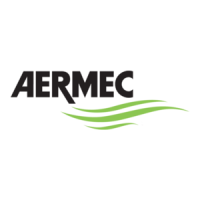English
20
IFCLIJ 1107 - 4528500_04
FUNCTIONING
- Functioning in cooling mode: using
the remote control it is possible to
set the cooling mode and the room
temperature desired by the user (set).
If the fan speed is set in automatic
mode, the control board will select
the fan speed and decide on the
opening of the water valve depending
on the difference between room
temperature set by the user (set) and
the temperature detected by the room
probe. In the case, with 4 -pipe system,
in cooling mode, the control board will
pilot the cold solenoid valve while the
hot solenoid valve is closed.
- Functioning in heating mode: using
the remote control it is possible to
set the heating mode and the room
temperature desired by the user (set).
If the fan speed is set in automatic
mode, the control board will select
the fan speed and decide on the
opening of the water valve depending
on the difference between room
temperature set by the user (set) and
the temperature detected by the room
probe. In the case of 2-pipe systems, in
heating mode, the control board will
pilot the standard solenoid valve. In the
case, with 4 -pipe system, in heating
mode, the control board will pilot the
hot water solenoid valve (accessory),
while the cold solenoid valve is closed.
- AUTO functioning (Automatic): by
activating "AUTO" mode on the remote
control, the room temperature is
decided by the control board, which
will also select the fan speed (functions
in Automatic). The thermostat
reads the room probe SA (always
continuous even in heating mode even
if thermostat is enabled) and decides
whether to function in heating, cooling
or dehumidification mode. From the
remote control it is possible to correct
the work set by the control board by
± 5°C. The unit will automatically
re-select the functioning after every
start-up from stand-by.
- Heating mode functioning with
electric resistance: if the unit foresees
an electric resistance, the only fan
functioning speeds allowed will be
maximum (V3) and medium (V2), the
minimum speed (V1) will be activated
automatically only in the post heating
phase. Using the dip-switches it is
determined in the installation phase
whether the electric resistance is active
in integration or replacement.
Heating functioning mode with
resistance in integration: the resistance
is activated at the same time as the
hot water valve in order to increase
unit efficiency. Alternatively, if the
temperature of the water is insufficient,
the resistance is activated to make
up for the insufficiency of the yield
supplied by the coil to the water.
Ventilation starts-up later with respect
to the resistance (preheating).
Heating functioning mode with
resistance in replacement: the
resistance is activated only if the
temperature of the water is insufficient.
Ventilation starts-up later with respect
to the resistance (preheating).
- Water probe upstream from the valve:
the probe detects the temperature of
the water in the system.
- Continuous ventilation (in cooling and
heating modes): ventilation is always
active, the thermostat only controls the
water valves and the electric resistance.
- Thermostat ventilation (heating):
ventilation starts later than the
thermostat call in order to allow
the hot water to run inside the coil
(preheating).
- Functioning in dehumidification mode:
requests that cold water circulates
in the system. The ventilation speed
is always minimum. It is possible
to correct the work speed, fixed by
the control board, by ±5°C from the
remote control.
- Functioning with timer: allows to
program the delay on switch on or
switch off from 0.5 up to 12 hours. A
power cut causes timer settings to be
zeroed.
- Full Power functioning: ventilation
is forced at maximum speed, the set
temperatures are 32°C in heating mode
and 18°C in cooling mode.
- Stop due to power cut: after a power
cut, the unit re-starts with the settings
activated before shutdown, only the
timer is reset.
- Delayed start-up: the unit can start
up ventilation later with respect to
switch-on, normally up to 2'40" but in
particular conditions the stand-by time
may be extended.
- SW4 probe: the installation of a probe
for the detection of the temperature of
the water that circulates in the system
is envisioned as an optional.
- Emergency control: if necessary, the
“AUX” key is available on the receiver
grid, which activates the "Auto-
Emergency" mode. In this mode, the
unit functions in automatic, depending
on the room temperature read when
the "AUX" key is pressed. If Auto-
Emergency functioning mode is
selected, timer functioning is excluded.
Pressing of the "AUX" button is
indicated by an acoustic signal. Switch-
off takes place by the same “AUX“ key.
Description of fan coil functions with GLL-M and GLL-R grid units
The same FCL unit can be coupled to
several grid accessories that determine
different functioning modes.
The particular information is supplied
in the manuals supplied with the
accessories. The features are recalled
here that differentiate the different
flow and intake grid units.
- GLL10 / GLL20
If an electronic control panel is to be
installed, check that the Dip Switch
settings inside the panel correspond
to system requirements, otherwise
modify the setting as indicated in the
instructions attached to the control
panel.
In the unit with 4-speed motors, select
the 3 fan speeds most suitable for the
system from the 4 available.
- GLL10M / GLL10R / GLL20R
Check that the Dip Switch settings inside
the electric box correspond to system
requirements, otherwise modify Dip
Switch settings.
In the unit with 4-speed motors, select
the 3 fan speeds most suitable for the
system from the 4 available.

